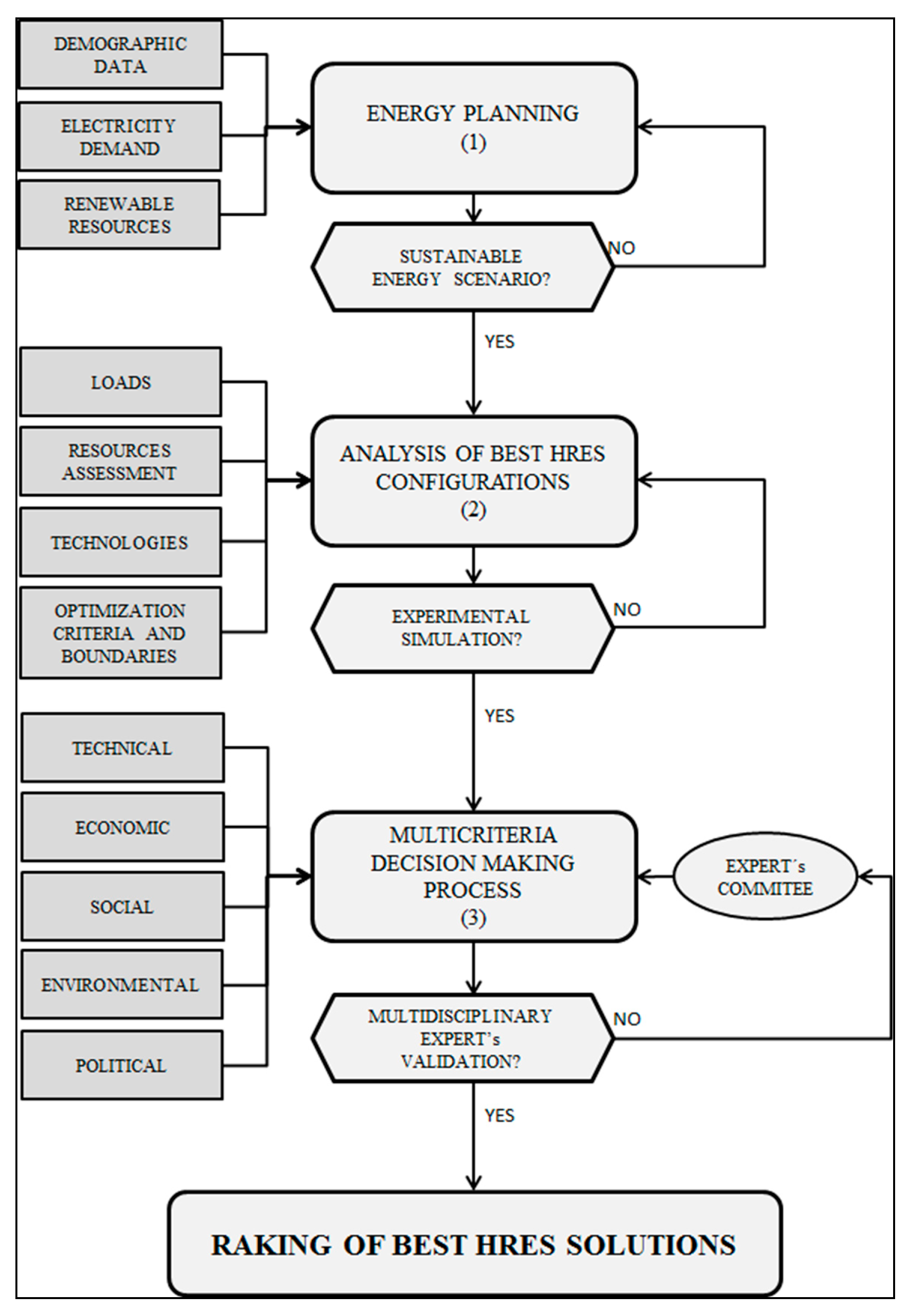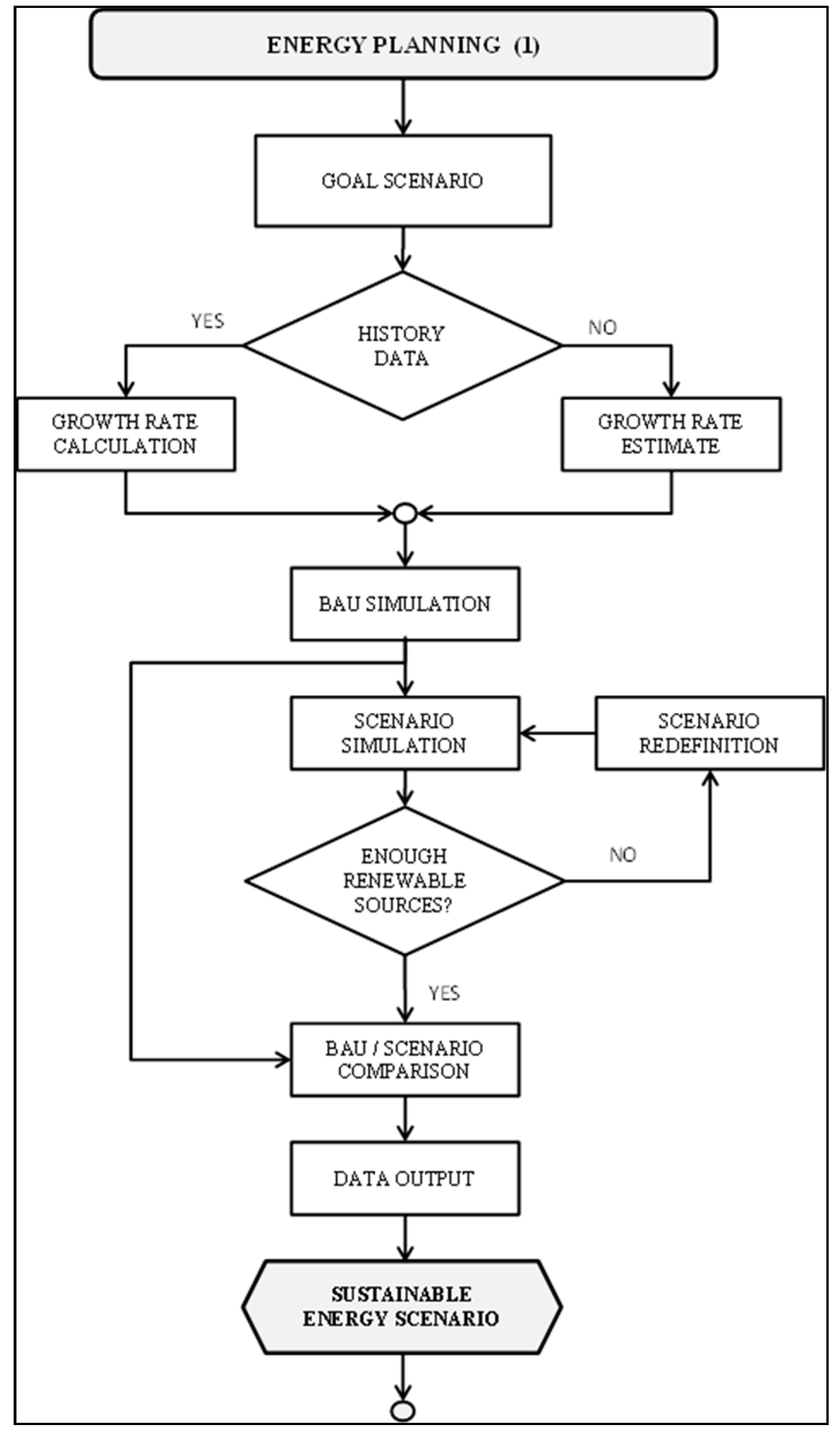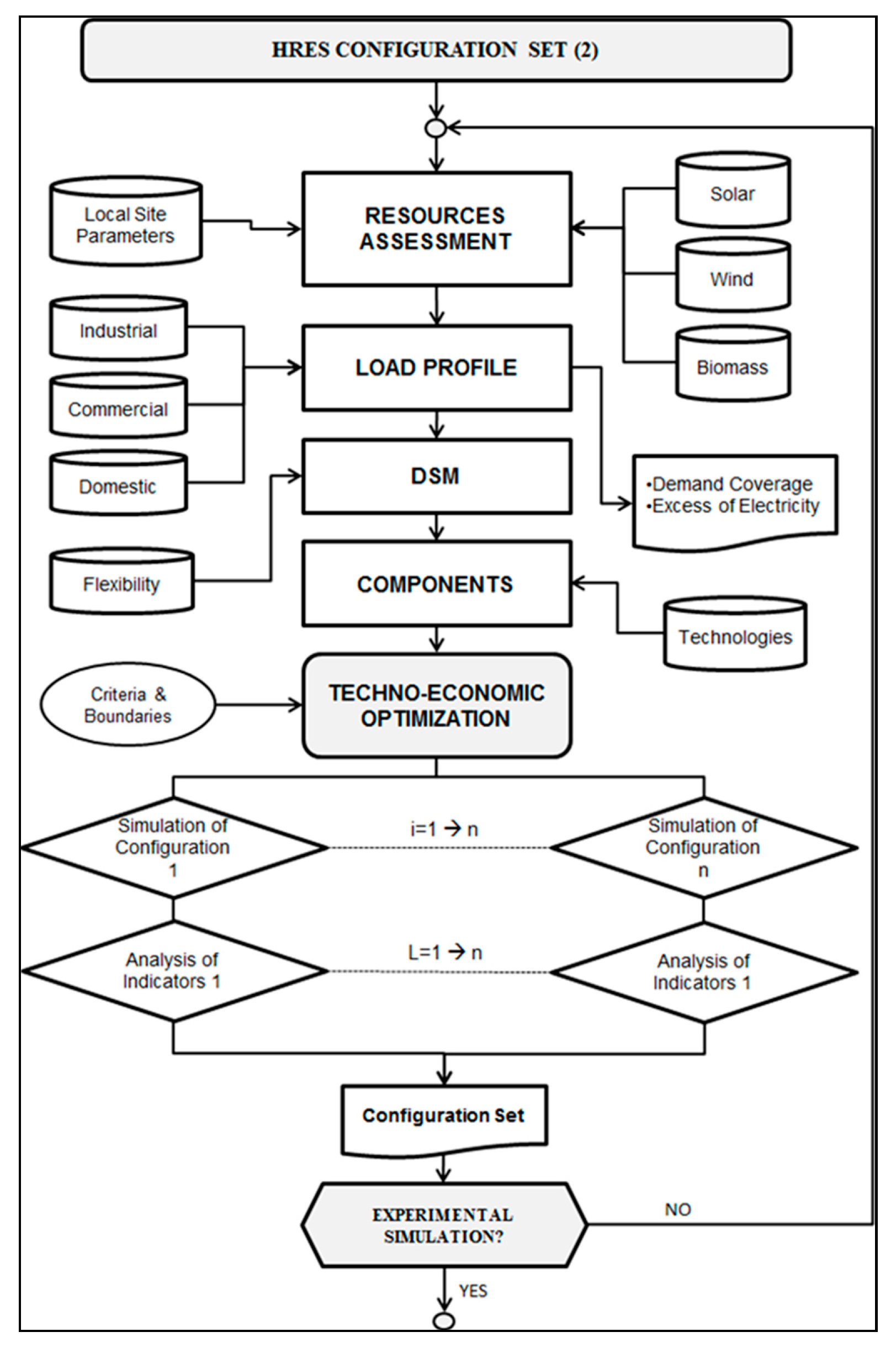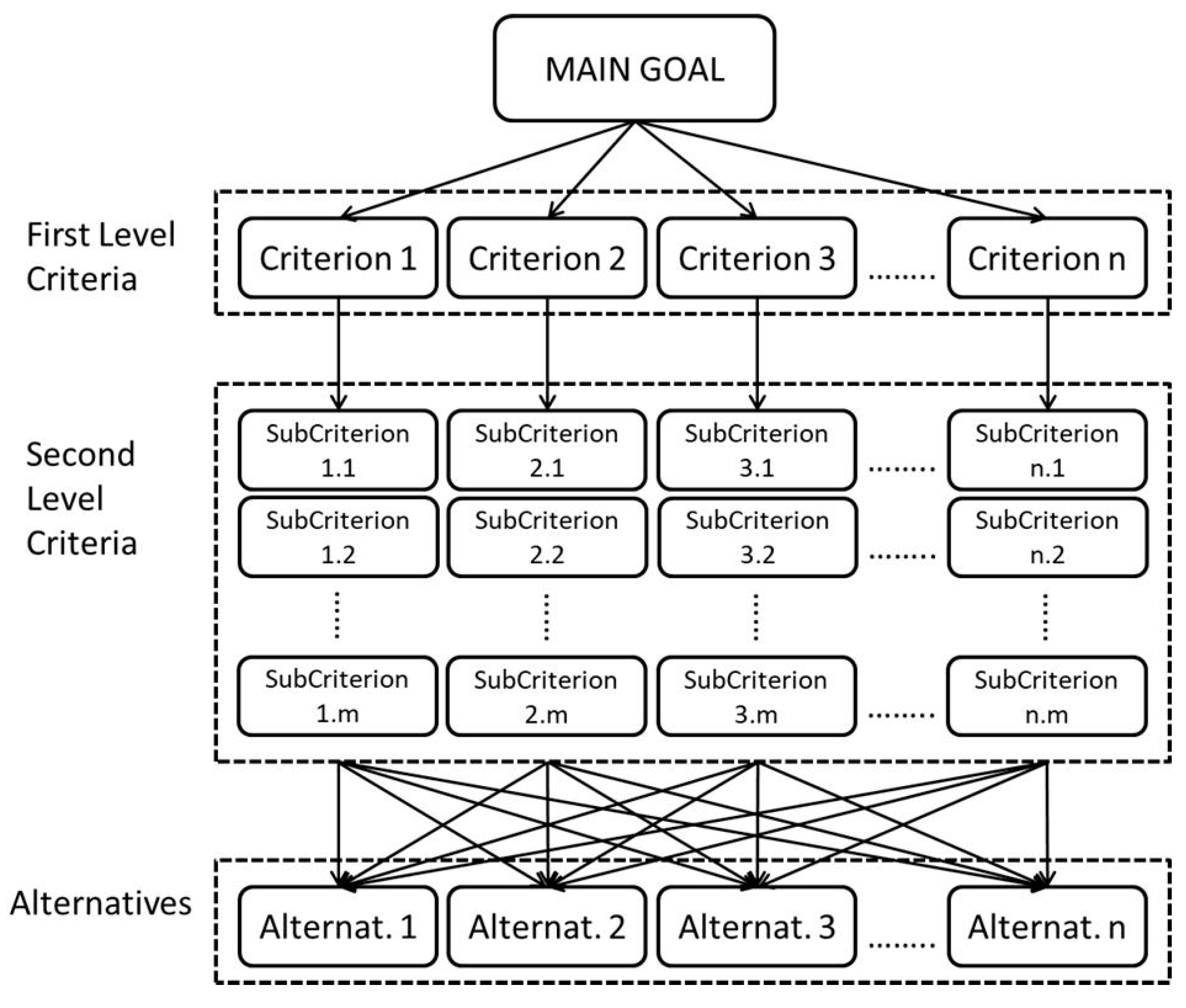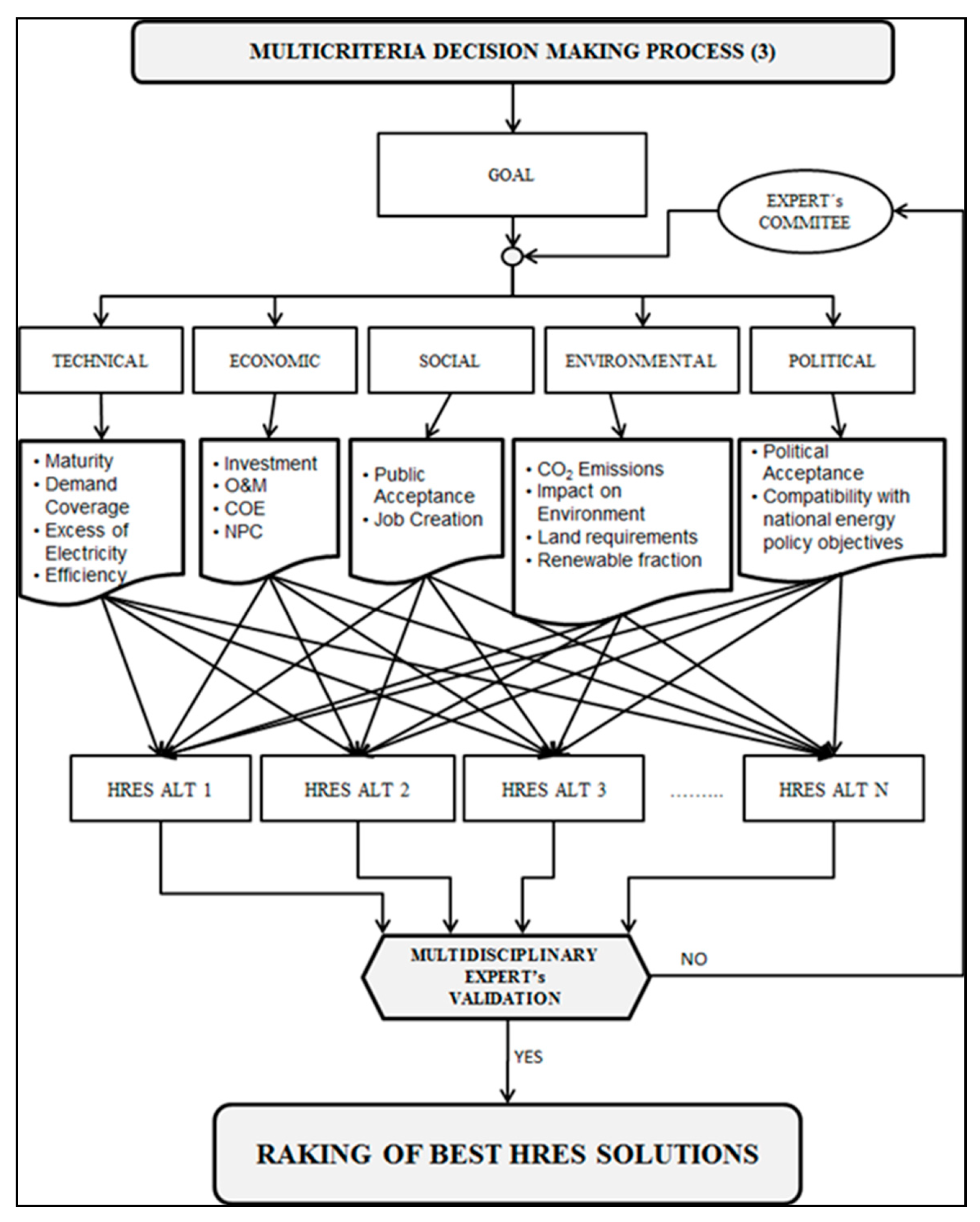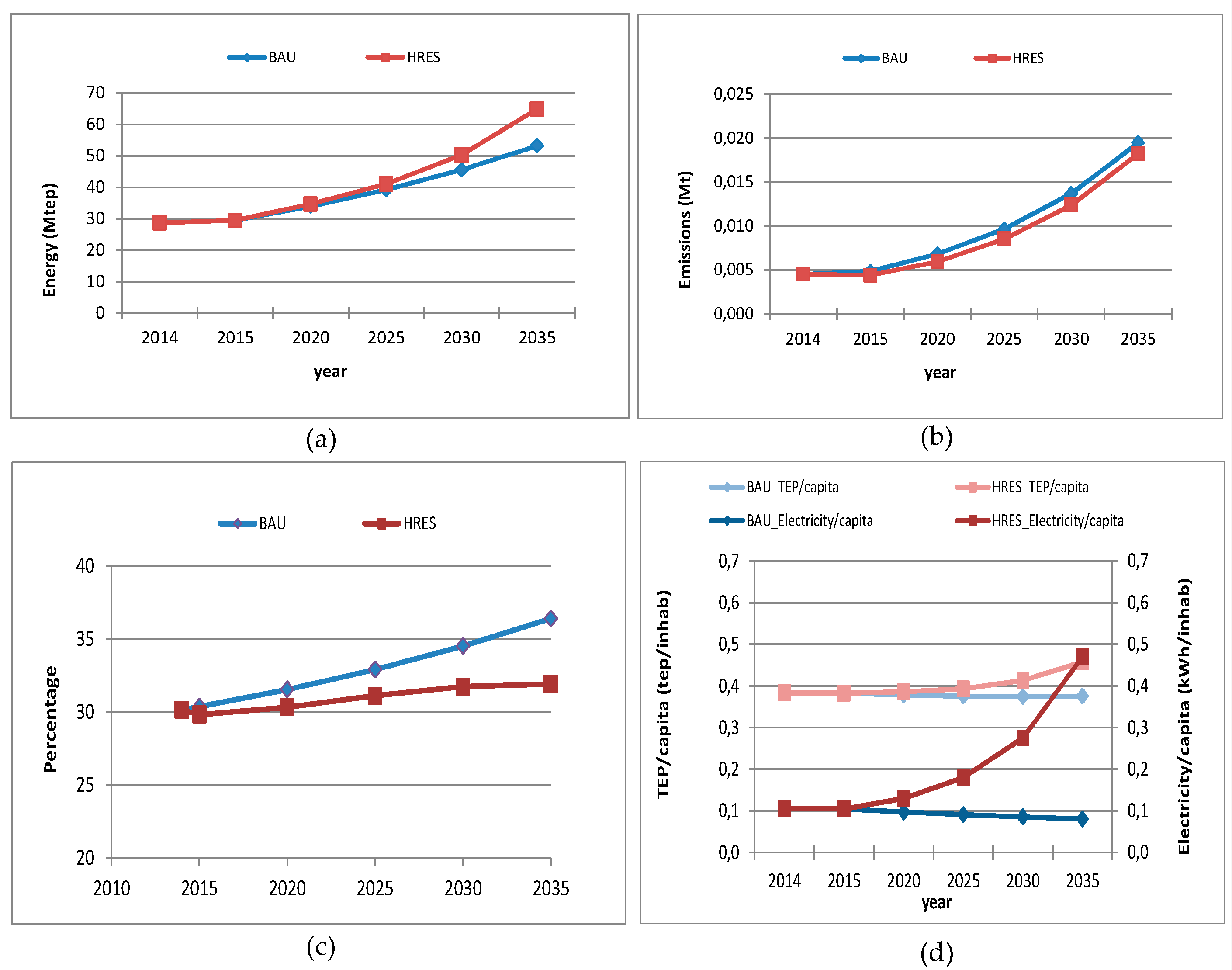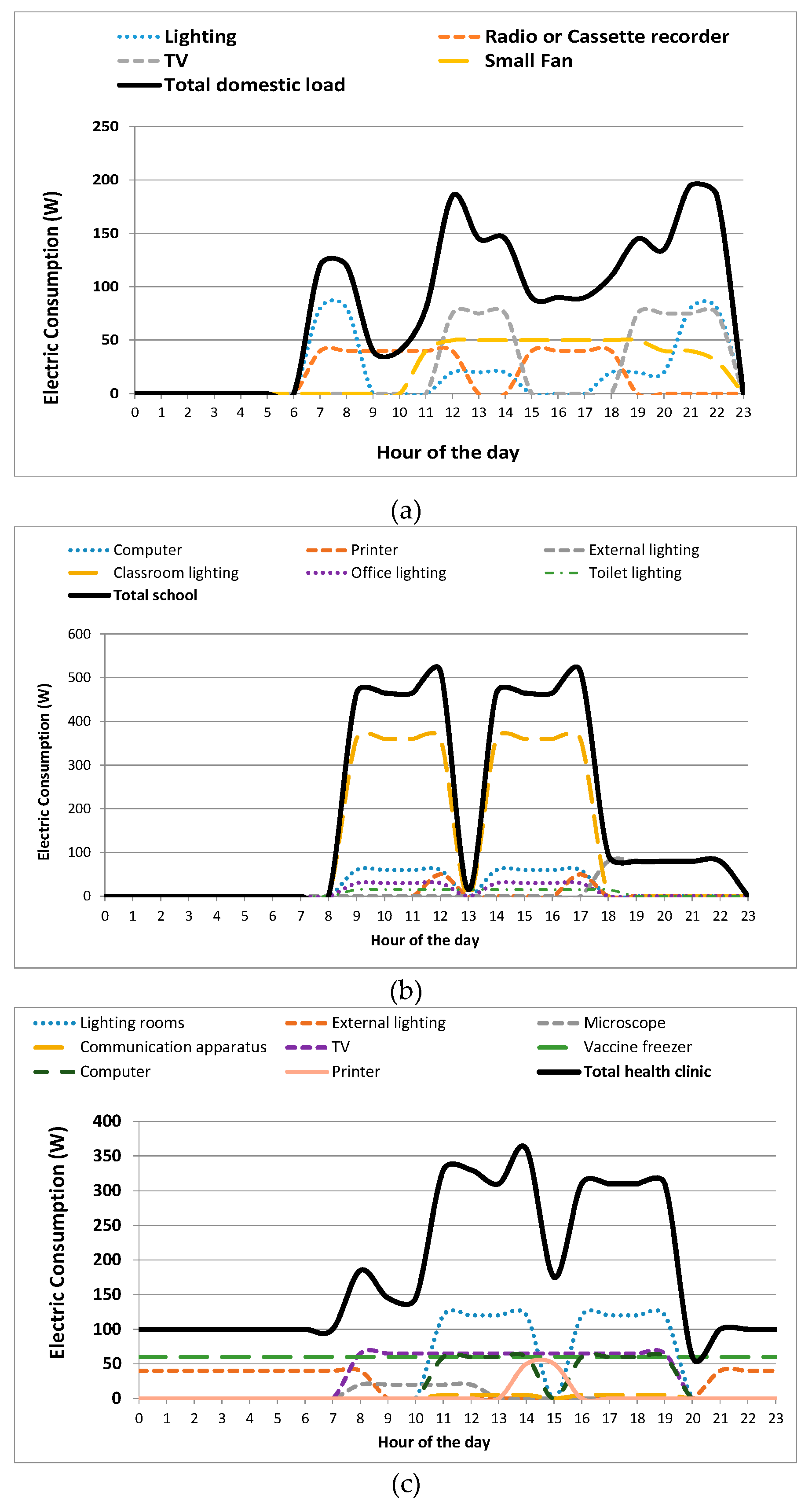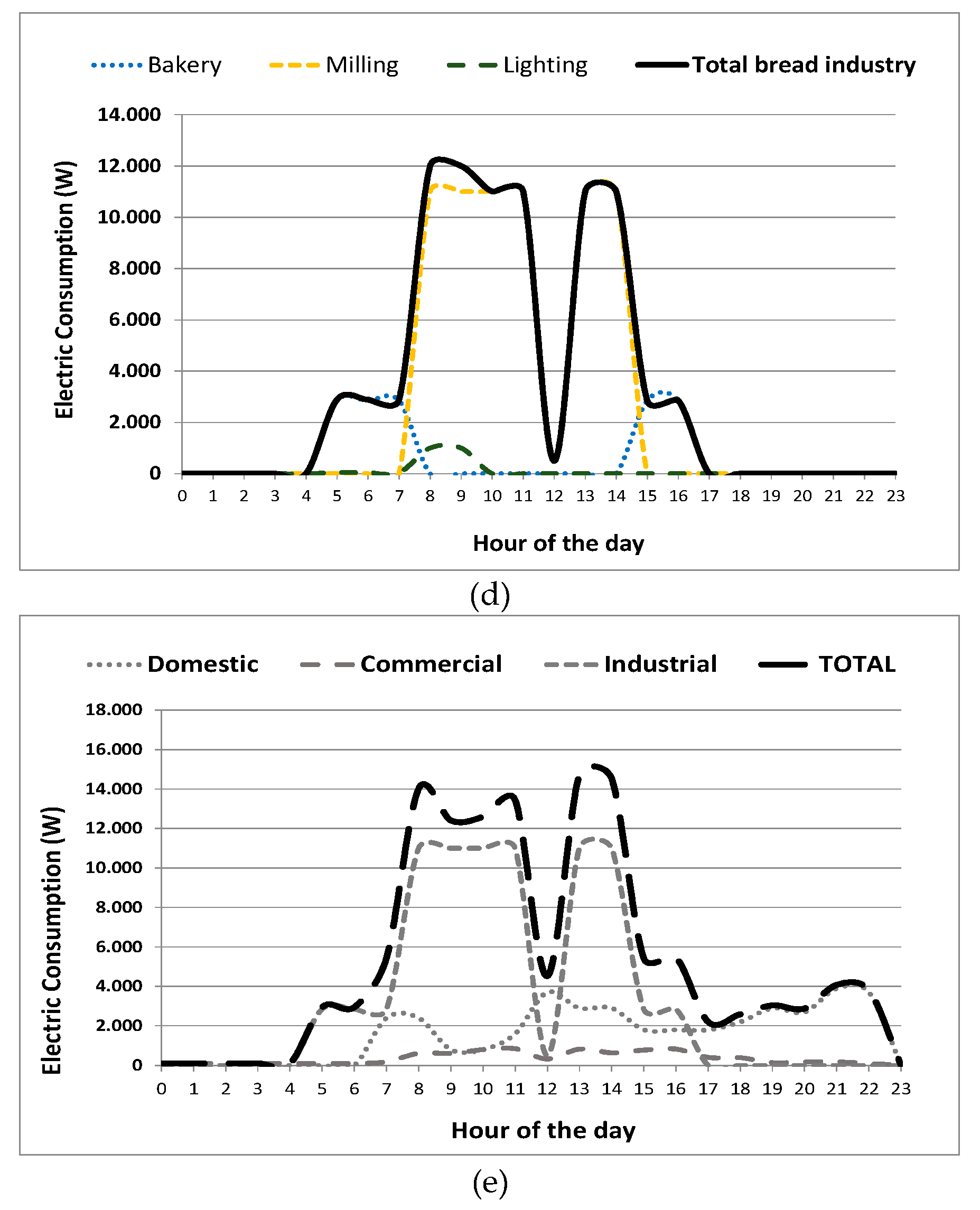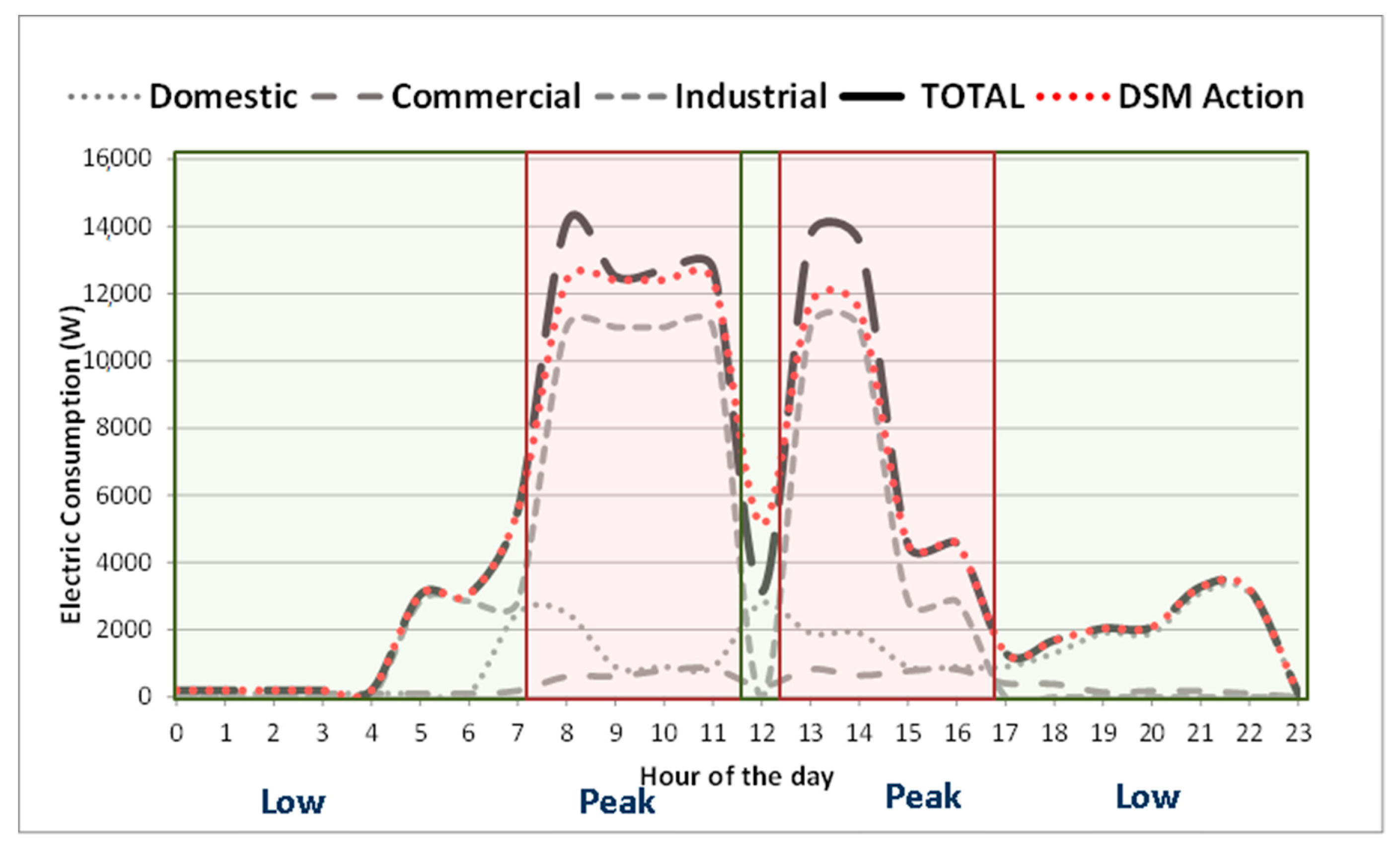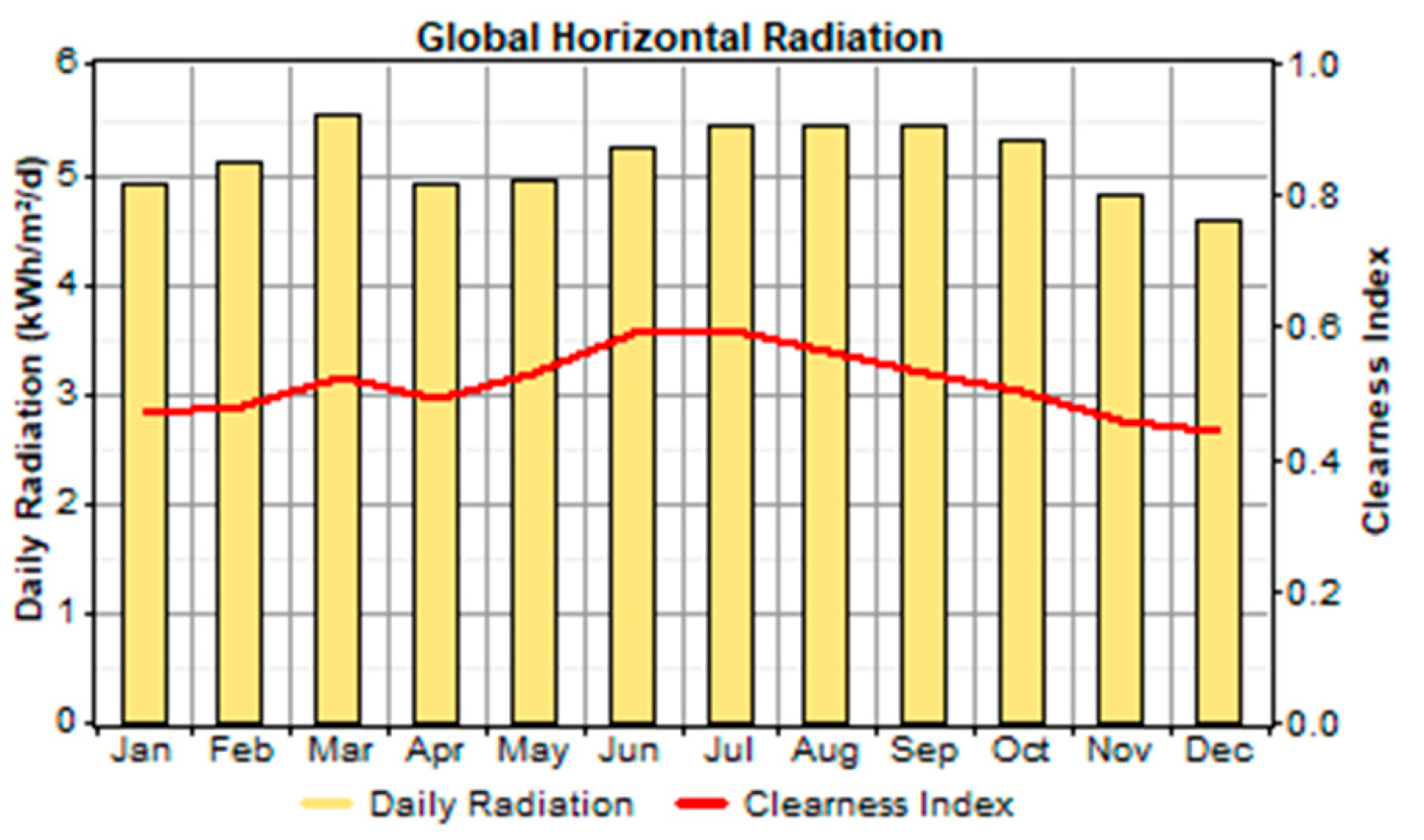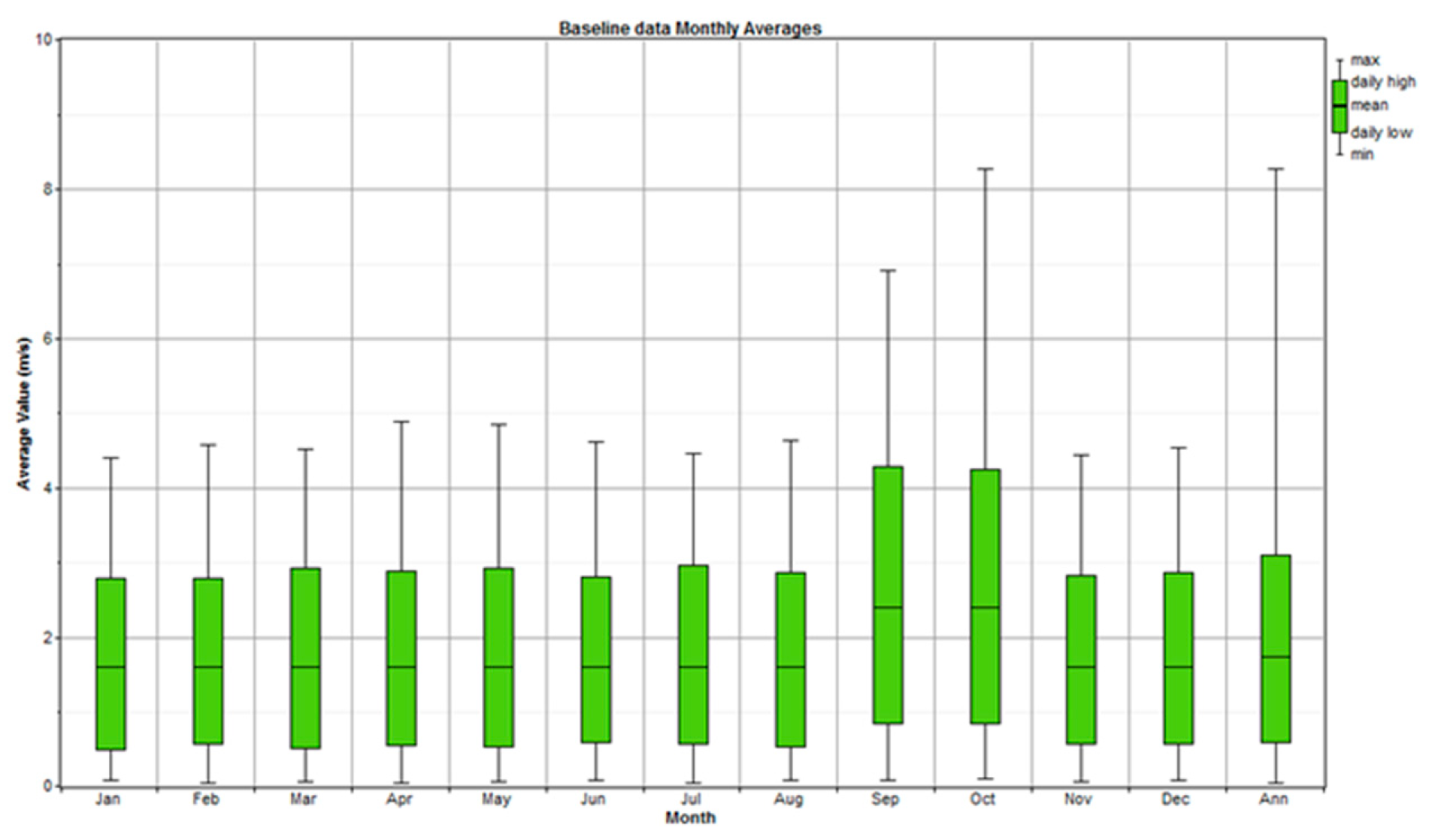1. Introduction
Economic growth of emerging countries is intimately related to reliable power supply, particularly in remote areas where poverty depends to a great extent on energy services accessibility. As stated by many international organizations, such as the United Nations [
1,
2], the World Bank [
3] or the International Energy Agency [
4], electricity provides the necessary framework for economic, social and human progress with a positive effect on productivity, health, education, climate change, food and water security, and communication services. Based on a prospective study carried out by the International Energy Agency (IEA), nearly 16% of the world population will still lack access to electricity in 2030 unless additional policies are implemented to palliate energy poverty [
5]. Also, in a complementary study on universal modern energy access, IEA projections for 2030 [
4] suggest that 60% of the additional power capacity will be achieved with sustainable energy systems, increasing 63% of the investment budget of mini-grids and off-grid systems based on renewable sources. Distributed power systems will emerge as an alternative solution to improve welfare and socio-economic development of small isolated communities, as islands and remote villages.
Energy Planning (EP) analyzes the various paths for energy evolution of a region by studying different energy scenarios. Each energy scenario involves assessing and matching energy sources and their conversion with the energy requirements of different demand sectors (commercial, industrial, domestic, etc.). Although it may seem a simple idea, it becomes a complex problem in which various decisions and criteria converge, together with the existence of complex relationships between the different actors involved in the simulation process: Generation, demand, emissions, economics, and technologies [
6,
7]. Remote and non-connected areas do not normally use energy planning in their energy analysis due to their small size. Their electrification plans normally follow modest structures, implementing simple solutions based on one technology, the most suitable one depending on the available natural resource (solar radiation, wind, type of biomass residues, etc.) [
8,
9]. These structures mainly referred to stand-alone systems based on photovoltaic and/or wind configurations, storing the excess of energy in batteries and using diesel generators as backup. However, this approach does not take into consideration other important factors, such as: Energy needs of the population, potential flexibility of consumers, expected demand’s growth and synergies between different renewable generation systems, which should be address by analyzing more in detail the different variables and relationships involved in the corresponding energy plan.
Global concerns on climate change justify renewable energy utilization since it produces few or no emissions. In addition, the utilization of renewable sources diversifies the energy supply mix, ensuring both energy security and sustainability [
10]. In the case of large rural areas in dispersed countries, renewable sources become and can be utilized in a distributed generation approach to generate electricity [
11]. Distributed Generation (DG) refers to the concept of generating electricity near the customer, thus DG technology is considered as a promising alternative for electrifying geographically disadvantaged rural and remote areas [
12,
13,
14]. In fact, the rapid deployment of renewable energy technologies over the past years and the wider projection for the near future, raise challenges and opportunities for their integration that should be taken into consideration in the strategies for energy planning and optimization methods of the electricity supply of isolated areas.
Nowadays, energy demand of a remote area is usually met from locally available renewable energy sources like solar, wind, hydro or biomass micro plants. The solution for electrifying an area is usually single-system based, however the synergy by combining renewable energy sources with back-up units in renewable hybrid systems (HRES) may provide an economic, environmental and reliable supply of electricity for power demand at isolated regions. Several research works have demonstrated the suitability [
15,
16] of HRES to extend renewable energy penetration in a developing region and the immense potential to meet the load demand of remote, isolated sites while supplying uninterrupted power at zero emission level [
17,
18].
Energy demand characterization of an isolated area depends on various factors: geographical location, population, economic activity, annual demand and demand growth rate, etc. The location is important to determine the electrical demand patterns since they highly relate to geographical site and cultural habits. Islands normally represent communities with higher energy demand and potential use of natural resources for electrical generation and storage; while remote villages include communities that may or may not be geographically isolated, therefore have the possibility of grid-connection in some cases. Demand determination and its evolution is an important element for the determination of the energy system to be installed in the isolated community.
Demand side management (DSM) actions normally aim to reduce peak demand by either, decreasing total energy use or shedding the loads to a more convenient time. The use DSM strategies in power sector have evolved significantly during the past 20 years [
19]. Electrical generation at isolated areas based on renewable sources, which are non-continuous and difficult to predict, requires the use of back-up systems to increase reliability of the global system, such as battery banks or diesel generator systems. However, these systems carry other environmental problems, such as disposal after use for few years, in the case of the batteries, or use of a contaminant fuel as diesel. DSM strategies can significantly benefit the global HRES by alleviating daily peaks and filling load curve valleys to obtain a better fit between generation and demand curves [
20,
21] reducing the size of backup system to be included.
Multi-criteria decision models (MCDM) [
22] is a branch of operation research models in the field of decision-making. These methods tackle both quantitative as well as qualitative criteria and analyze conflict in criteria and decision making [
23]. Multi-criteria analysis is used to select the ‘‘best fitted’’ solution from multi-attribute distinct options in a multi-dimensional space of different indicators and objectives. The use of multi-criteria decision analysis techniques provides a reliable methodology to rank alternative energy solutions for rural communities, considering renewable energy resources, technologies, demand and environmental impact [
24].
State of the art review, including research studies in decentralized planning, electrification of isolated areas and multi-criteria analysis, together with the exploration of projects for electrifying remote communities with renewable energies, reveal a significant effort carried out by the scientific community in the last years. It also denotes the noteworthy interest in the different aspects associated to remote electrification of communities: software development for decentralized planning, including HRES; strategies for HRES control to maximize demand coverage; integration of demand side management, optimization of design system’s operation to respond different demand profiles; decision-making approaches.
However, all these scientific and technical works deal with specific issues of the challenge, but it has not been identified in the literature a comprehensive methodology for HRES optimization considering decentralized planning and multi-criteria assessment of quantitative and qualitative aspects of the project, which are key in the success of real implementation projects.
This article presents a methodology to assess the potential of hybrid renewable energy generation, evaluating possible mix-configurations, together with demand side management strategies and energy storage. In summary, this methodology improves the quality of energy services to non-connected areas from three main approaches: Technical, economic and sustainability.
The research work is organized into three major stages. First stage carries out a macro analysis, defining the method for analyzing the energy context of the country where the area is located and analyzing its evolution towards a sustainable energy scenario based on renewable energies. This allows understanding the advantages and limitations for massively deploying renewable hybrid power supply at different locations (villages, cities, regions, etc) in the country.
Then, it is analyzed whether the integration of different renewable energy systems are feasible at a micro level, carrying out a local analysis of the implementation of sustainable technologies as a means for local development of the emerging country. This micro-analysis responds to the implementation of macro policies established at the national level. At this stage, it is identified the most promising configurations of hybrid renewable systems capable to respond to the energy needs of the pilot area.
In the third step it is introduced the method of multi-criteria analysis which allows to select, among the promising configurations identified in the previous stage, the most appropriate for the specific context of the area under study. This approach takes into account not only economic or technical aspects, but also sociological, political, and environmental criteria.
Finally, it is presented the results of the methodology applied to a case study in order to show its usability and potential. A standard isolated community in Democratic Republic of Congo has been selected for this application since 90% of the population is living in areas isolated from the mains; despite it is one of the African countries with the greatest potential for renewable energy generation.
2. Materials and Methods
This section summarizes the integral methodology for isolated areas electrification developed in this study. It includes three main components: sustainable energy planning, identification of the most promising HRES configuration and multicriteria decision process. Then, this methodology is implemented in a case study, which was carried out using the support of several tools. Sustainable energy planning was studied using SIMESEN v5, a tool for analyzing the impact of different energy scenarios [
25,
26]. The tool SIMESEN, used for simulating energy scenarios, was specifically developed for analyzing the potential of meeting the energy demand of a remote area with renewable hybrid systems. The study of combining different renewable energy technologies to meet the demand was performed using HOMER Energy [
27]. HOMER is a software application used for dimensioning and evaluating technically and economically the options for off-grid and on-grid power supply in microgrid and distributed generation power systems. Finally, it was used the AHP method [
28] to perform the multi-criteria assessment with the support of Super Decisions v2.10 software [
29], a decision support tool for AHP and ANP implementations.
Existing planning tools, such as EnergyPLAN [
30] or LEAP [
31] are not specifically oriented to this task. In the case of EnergyPLAN is more oriented to the system operation instead of the design or economic investment optimization, while LEAP does not currently support optimization modelling and it is oriented to support a number of different modelling methodologies. The code developed in this work, SIMESEN [
25,
26], allows studying the evolution of sustainable energy indicators of a particular energy scenario using as starting point the energy demand and the primary energy. Then, it allows analyzing the role that renewable energies could play to enable a sustainable scenario within a predetermined timeframe. Once this participation is determined, the possible configurations of HRES that comply with this scenario are determined and, depending on the remaining elements to be considered: Required technologies, environmental impact, costs and demand participation, obtain through a criterion of multi-criteria optimization, the most appropriate HRES to the needs of the population under study (
Figure 1).
2.1. Energy Planning
SIMESEN is based on a linear model that relates the demand with the possible contributions of each primary energy source and electricity, and provides for the considered scenario the evolution of each of these contributions and the emissions generated by them in order to evaluate the sustainability indicators [
25,
26].
The evolution of the independent variables, which are assumed to be the energy demand of each sector are defined by predetermined mathematical laws or, in the most usual way for this type of analysis, by numerical annual rhythms of variation [
26].
where the following variables have been used (
Table 1):
In order to quantify the degree of compliance with the sustainability objective, and the evolution followed to achieve it, the following indicators have been used based on the most frequently used in the literature:
Population;
GDPppp;
Consumption of Electricity;
CO2 Emissions;
Primary Energy (EP);
EP Generated;
Electricity Import-Export;
Generated Electricity;
External Dependency;
GDPppp/capita;
TEP/capita;
TEP/GDPppp;
Electricity/capita;
CO2/TEP;
CO2/GDPppp;
CO2/capita;
Renewable Fraction in Primary Energy;
Renewable Fraction in Final Energy.
Block diagram of the SIMESEN code is presented at
Figure 2.
2.2. Configurations of Renewable Hybrid Systems
Once the energy planning study is completed, the methodology addresses the optimization of HRES configuration, following the scheme depicted at
Figure 3.
First, natural resource evaluation is carried out based on local site parameters, such as meteorological data and geographic profile of the area. Meteorological data includes solar radiation, wind speed and direction, temperature, humidity, etc. This data helps determining the potential for RES power generation in an area, together with the required power technologies. The majority of isolated villages are characterized by having generous solar radiation and/or wind speeds (especially in the case of mountainous regions), as well as significant biomass residues since most isolated communities have agriculture as main subsistence activity.
Second, it is performed a detailed study of the different load profiles (domestic, commercial and industrial) in order to estimate the power needs of the community. To do so, it is studied the main consumption in domestic (households), commercial (health clinic, school, etc.) and industry (bakery, small business, etc.). Based on these profiles, it is identified the renewable hybrid configurations to supply energy to it.
Most typical load curve for rural villages is normally composed by 3 main components [
32]: A base load, a morning/middle peak and an evening peak (
Figure 4). First one is the base load, which generally represents night and early morning hours with limited or non-existent load during nocturne hours in the case of small communities. This load level is generally low compared with the morning-middle and evening peaks. Second one is the morning-middle peak, which builds from base load and refers to the activities from breakfast to lunch. Last one corresponds to evening activities, which is the highest peak and refers to lighting and entertaining activities, such as TV watching. Generally, this demand is supplied by stand-alone renewable power systems such as PV, wind, hydro or biomass, together with a storage system (battery bank) and a back-up generation system like a diesel generator.
In the third place, different types of Demand Response (DR) strategies are considered to achieve a more reliable power supply through responsible consumer’s behavior by means of energy conservation, energy efficiency, load curtailment and fuel substitution programs. Main types of demand response mechanisms are tariff pricing and economic incentives for customers [
33,
34]. In this instrument, customers decide when to consume. There are different electricity prices depending on the time of the day. This instrument encourages consumers to have specific usage patterns, consuming energy during periods with lower tariffs in order to reduce their electrical bills [
33].
Once the abovementioned customer actions are implemented, next step in the methodology is identifying possible HRES power systems to cover the “updated” demand which considers demand flexibility actions in critical conditions, simulating from the simplest to more complex: Renewable stand-alone power systems (with or without storage); HRES with batteries or other storage systems, and micro-grid systems. Technical and economical characterization of the required technologies for the depicted configuration is provided in order to understand their limitations, but also the strong aspects of each component.
Once resource assessment, load requirements and available technologies have been analyzed, it is necessary to define the boundary and constraints for the techno-economic study. Throughout the evaluation of all possible combinations of renewable hybrid systems and sizes, the optimization process discards any solution that does not comply with imposed constraints, such as: Maximum Annual Capacity Shortage (MACS), Minimum Renewable Fraction (MRF); Load Following Strategy, and Cycle Charging Strategy. In this study, it has been defined a project time boundary of 25 years, with the following technical limitations: HRES power generator should respond to the requested demand at all times and renewable fraction of the supplied energy should be higher than 50%. Considering these inputs, it is simulated a series of possible configurations with HOMER to obtain a set of possible HRES configurations that satisfy all constrains, ranked from cheaper to more expensive systems. Hybrid Optimization Model for Electric Renewables (HOMER) software [
27] is one of the most powerful tools for HRES configurations and sizing. It is the one of the most used tools in energy studies for remote areas without grid access. This software compares the energy generated by each HRES alternative with load needs at each hour for a complete year (8760 h). It simulates each possible HRES configurations, calculating the Net Present Cost (NPC) of each system. The optimization criterion is to minimize this NPC, which includes the costs of the initial investment in construction, the replacement of component within the project lifetime, its maintenance and fuel expenses. Another important economic parameter is the levelled cost of energy (COE) as the average cost per kWh of useful electrical energy produced by the system. COE takes into account the annualized capital (initial) cost, annualized replacement cost, annual O&M cost and annual fuel cost.
The concept of annualized cost (
), especially for initial investment, is mathematically expressed as:
where:
: is the initial capital cost of the component (Eur);
: is the capital recovery factor;
: is the real interest rate;
: is the project lifetime.
The Capital Recovery Factor (CRF) is a ratio used to calculate the present value of an annuity (a series of equal annual cash flows), using the following equation:
where:
2.3. Multi-Criteria Assessment
Last step in the methodology presented in this study is the multi-criteria assessment of HRES feasible solutions, which is approached using the Analytic Hierarchy Process (AHP) [
32]. AHP is one of the most commonly used methods of multi-criteria analysis, which considers hierarchical process with multiple levels. At the top level of the hierarchy is the goal, next level includes selected criteria, and the lowest level consists of the possible alternatives. In each hierarchical level paired comparisons are made with judgments using numerical values taken from the AHP absolute fundamental scale of 1 to 9 (
Figure 5). These comparisons are used to set matrices in which eigenvectors are defined from ratio scales. AHP combines multidimensional scales of measurement into a single one-dimensional scale of priorities. The method also calculates a consistency ratio (CR) to verify the coherence of the judgments, which must be below 0.10 to be acceptable.
The methodology applies AHP to a selected set of HRES configurations. It aims to identifying the most convenient HRES solution from the alternatives deduced in the previous steps, using four criteria: technical, economic, environmental, social and political. Each criterion includes several sub-criteria that are also studied with AHP.
In the case of the Technical Criteria, the sub-criteria are: Maturity of the technology to be used; percentage of total demand covered by HRES configuration; surplus of electricity that must be discarded because it cannot be used to serve a load or charge the batteries; autonomy provided by the battery bank.
For the Economic Criteria: Initial investment; O&M cost; Cost of Electricity (COE); Net Present Cost of the system. For the social criteria: Public acceptance and Job creation.
For the Environmental Criteria: CO2 emission; Percentage of HRES´s total energy production generated from renewable power sources; Impact on environment and biodiversity, and land requirements.
Finally, for the Political Criteria: Political priorities in terms of energy and the promotion of renewable power supply, and compatibility with national/regional energy policies.
The AHP structure used in the methodology is presented in
Figure 6. This final step of the methodology allows ranking the most promising HRES configurations identified in previous stage according to their adequacy to the specifics of the area, considering quantitative and qualitative aspects.
4. Discussion
The sustainable development of countries with low electrification rates based on HRES is possible and should be accompanied by national and regional energy directives. Enhancing HRES in remote communities will provide energy access to isolated areas, promoting the economic development of these communities without increasing CO2 emissions. Responding to this, the first stage of the methodology studies the impact and requirements for HRES deployment in remote areas based on a series of sustainable energy indicators. Although the main purpose of this stage is to provide power supply to grid-isolated areas, the study promotes the use of distributed renewable systems near to the demand.
HRES modelling and simulation of off-grid HRES configurations may be optimized on a second stage based on the electricity load, climatic data sources, and economics of the power components in which the NPC has to be minimized to select an economic feasible power system. However, in a third phase is crucial to gather the opinion of local experts and local residents. During the implementation of the methodology to the case study, results of the second and third stage highlighted as the top-ranked HRES configuration the alternative including photovoltaics, diesel and batteries for storage. Among the alternatives, it was also evaluated the HRES configuration using a biomass gasifier system instead of diesel back-up generator, considering the abundant biomass resources in the area. However, the price of these systems is still expensive in comparison to diesel back-up system. AHP implementation showed that the main decision-taken driver is still the cost of the overall system and electricity cost. This conclusion denotes that an extra effort needs to be done in remote areas to enhance sustainable energy configurations with no fossil fuel generation.
Main result of this research is the comprehensive methodology for sustainable power supply which may be implemented in different areas or regions. It uses a holistic approach to interlink national/regional energy policies based on a sustainable development with small scale mini-grid projects based on renewable hybrid systems in specific community needs (political, social, technical, and economic). Results in the “HRES ranking of best solutions” will not be the same from one region to another, but the implementation of the methodology will follow the same procedure, which may serve as a tool for public and private organizations.
Similar research works focus on one of the stages of the challenge, either energy planning, HRES simulation or AHP method applied to energy technologies selection or power plant site. Most popular scientific works deal with software development for decentralized planning (including HRES), definition of HRES control strategies for maximizing demand coverage and challenges associated to the integration of renewable hybrid systems in the grid. However, these scientific and technical works address very specific aspects of the global problem. They do not address intangible aspects. The methodology presented in this paper fills this gap, interlinking national and regional policies with small-scale mini-grid HRES projects based on a participatory approach.
5. Conclusions
Electrification of rural areas will remain a challenge for governments in developing countries like Democratic Republic of Congo. Comparing renewable energy systems with conventional generation units powered by fuel may not be cost effective yet, but the necessity of environmental protection and global tendency toward more environmentally friendly habits will derive in a decrement of fossil fuels and its substitution by renewable energy technologies.
State of the art revealed an important effort carried out by the scientific community to study isolated areas electrification, mainly based on decentralized energy generation. However, these efforts mainly focused on technical operation challenges. Further to this, the process of decision taken in selecting and implementing feasible energy projects is a complex problem that needs to be tackled from different perspectives (technical, economic, social, environmental and political). In this regard, the use of multi-criteria methods is essential for the success and continuity of the project in the future. Responding to this approach, it has been developed a holistic methodology for the implementing mini-grid electrification projects considering the different perspectives.
This comprehensive methodology optimizes the quality of energy services to non-connected areas from three main approaches: technical, economical, and sustainability, assessing the potential for energy generation with renewable energies, evaluating possible hybrid configurations, together with demand side management strategies.
In addition, it analyses the available resources with potential for demand response actions for distributed generation and energy storage needs and integrate qualitative assessment of social and political aspects of the implementation of HRES in the isolated community using the Analytic Hierarchy Process. The methodology has been presented in this article and used, as a test case of its applicability and example of the procedure to follow in its application, to a local community located in the Democratic Republic of Congo.
